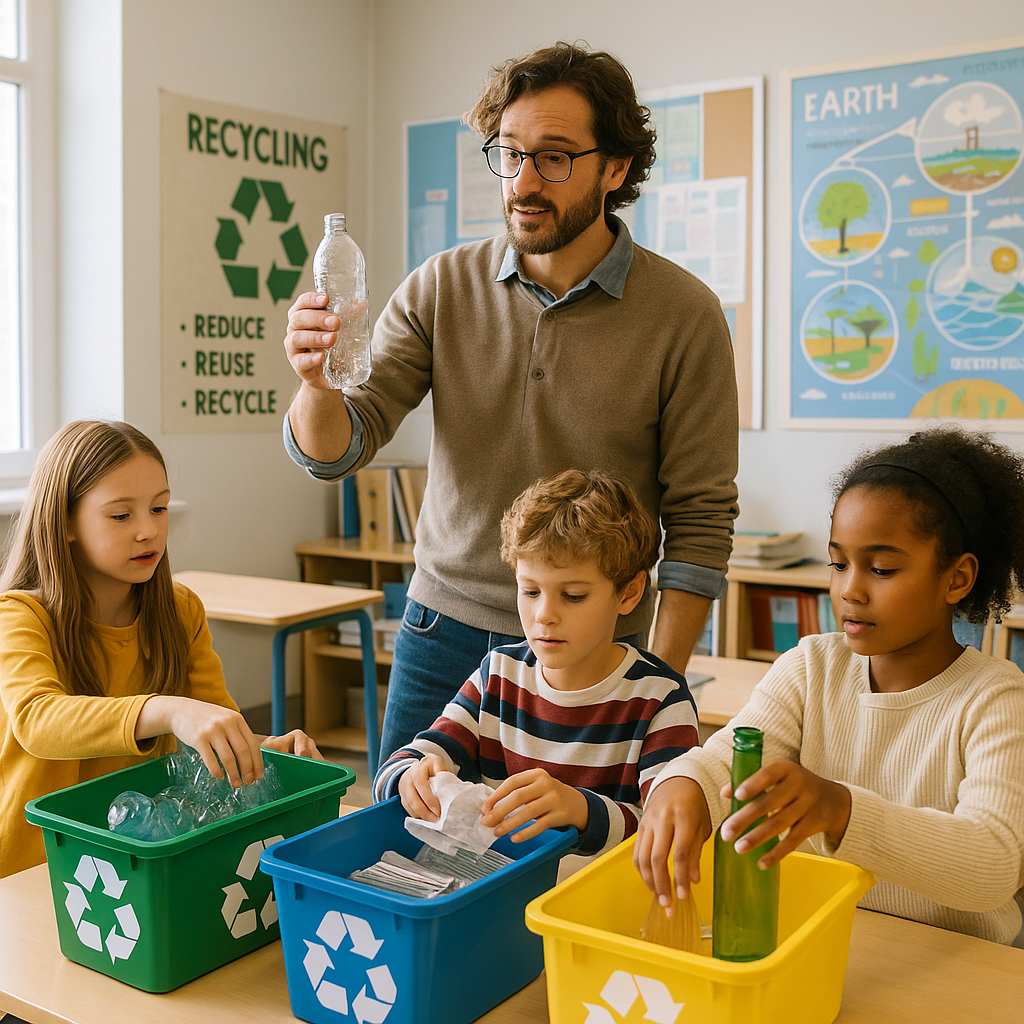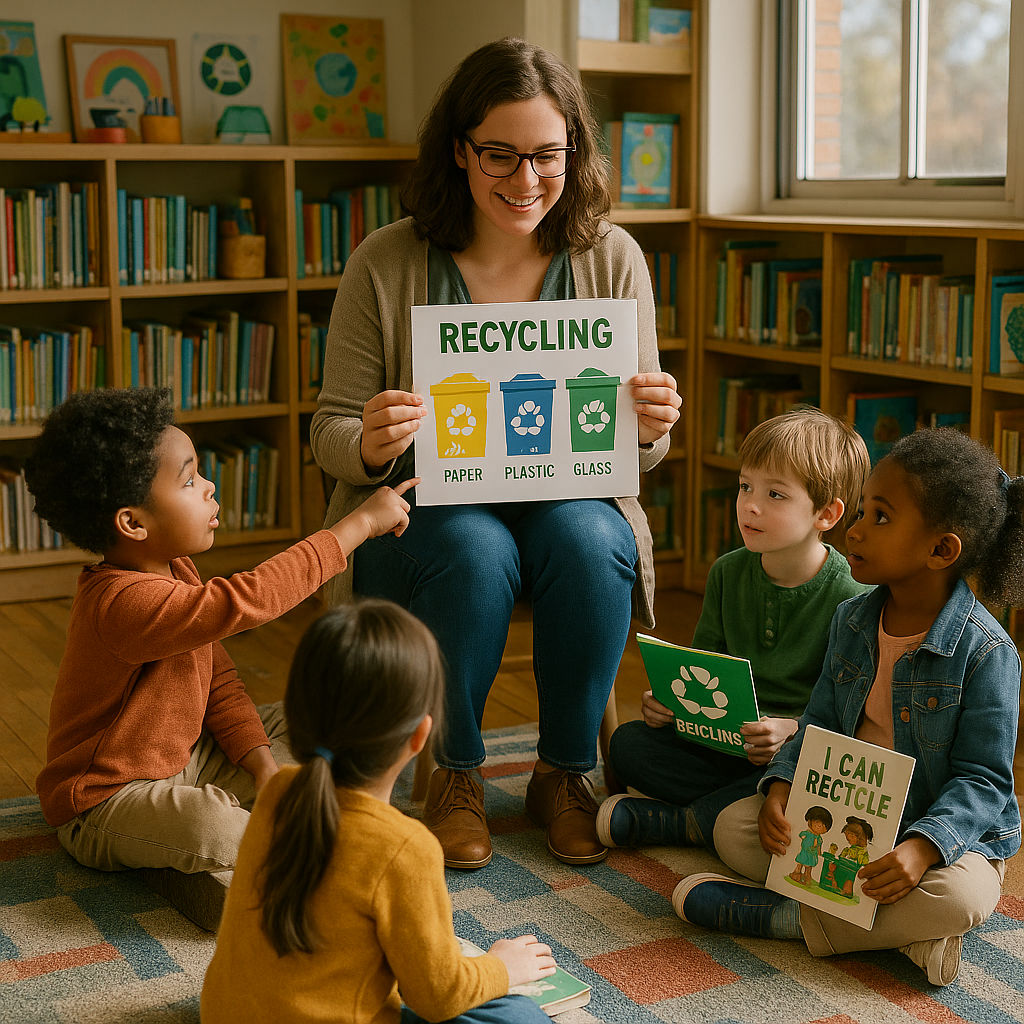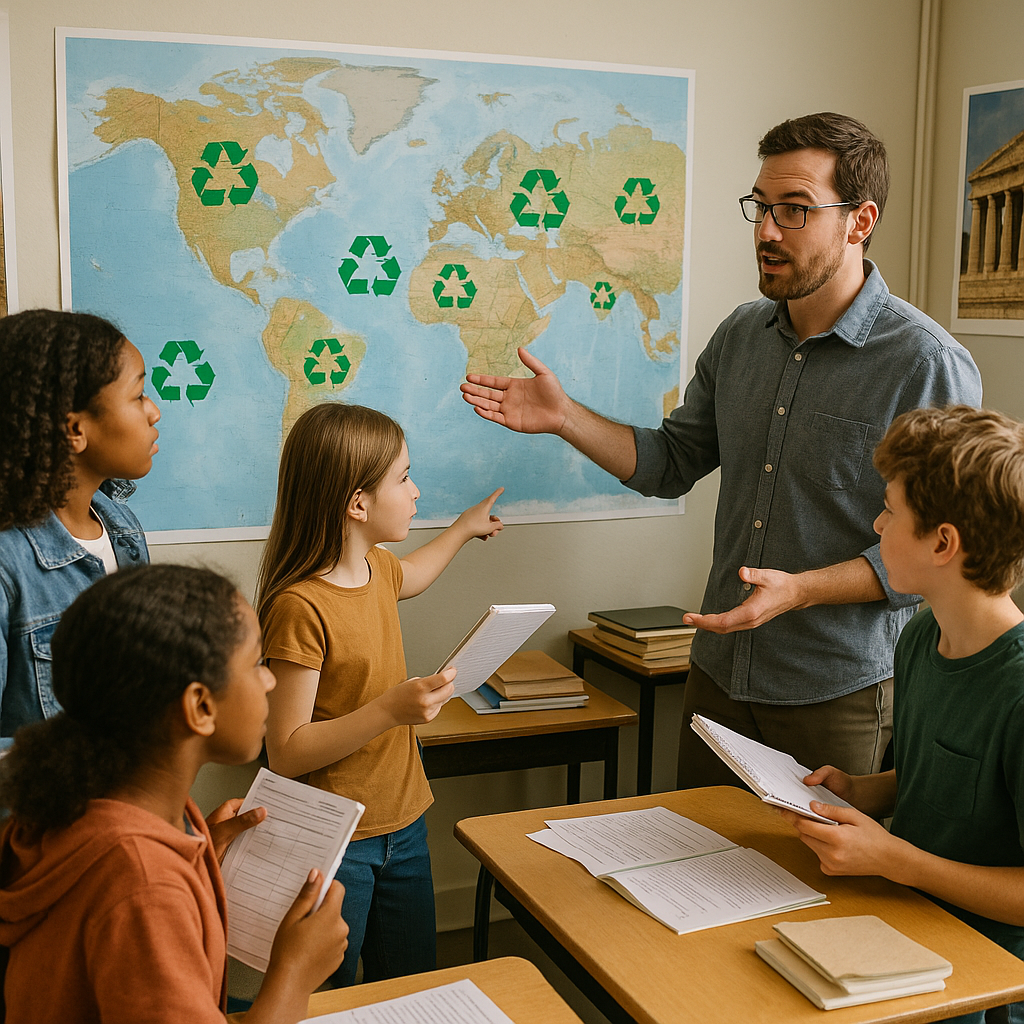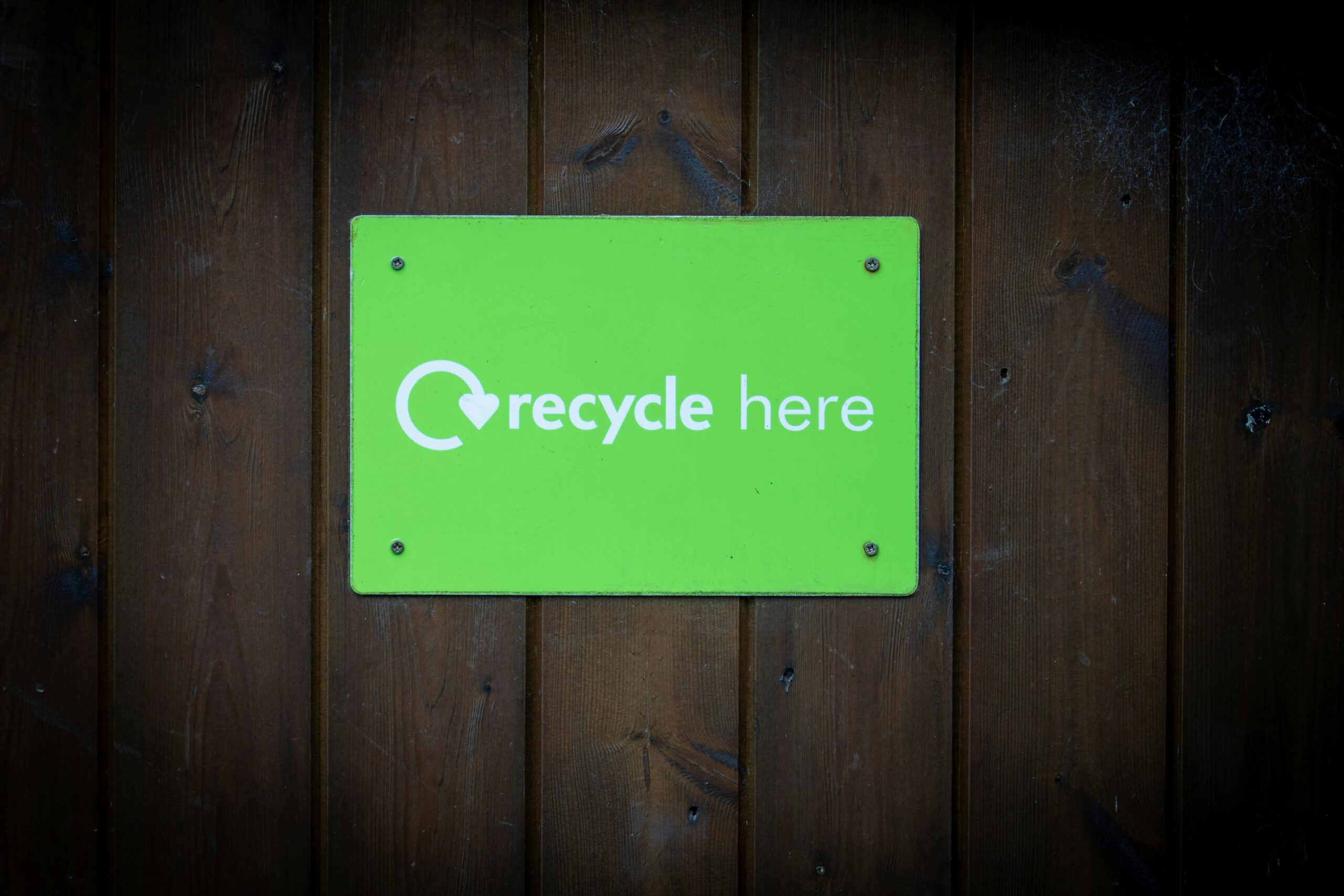5901 Botham Jean Blvd, Dallas, TX 75215
How to Integrate Recycling into School Curriculums
June 13, 2025Did you know that American schools generate approximately 4.7 pounds of waste per person each day? This figure underscores why recycling education in schools is essential. By integrating recycling into school curriculums, educators can transform how students understand and interact with their environment.
Recycling education provides a clear path to environmental awareness. When schools incorporate waste management principles into their teaching, they offer students practical knowledge about resource conservation. These lessons extend beyond the classroom walls as students bring these habits home, influencing family behaviors and creating ripple effects in communities.
The versatility of recycling education is its strength. Schools can integrate sustainability concepts into science lessons by exploring material properties and decomposition. Math classes can analyze waste diversion data and calculate environmental impact. Social studies can examine how different communities manage waste. Even art classes can engage in creative projects using recycled materials. This cross-disciplinary approach ensures that environmental awareness becomes a fundamental part of a student’s education rather than an isolated topic.
How Can Recycling Be Integrated into Science Classes?

Science classes offer ideal opportunities to introduce recycling concepts. Students can explore the chemical composition of materials, biological processes of decomposition, and the physics of resource conservation. These connections make recycling education both relevant and impactful.
Material Science Exploration
Chemistry lessons can include recyclable materials analysis. Students can examine different types of plastics, metals, and glass to understand their properties. This knowledge helps them grasp why certain materials are more easily recyclable than others.
In a simple experiment, students collect various plastic items with different resin identification codes. They can test properties like buoyancy, melting points, and reactivity to understand why separation is crucial in the recycling process.
Biology teachers can link recyclable materials to environmental topics. Students might compare how quickly different materials break down in controlled environments. This hands-on approach demonstrates why organic waste should be composted rather than sent to landfills.
Decomposition Studies
Material decomposition experiments provide excellent opportunities for scientific observation and data collection. Students can create mini-landfills in transparent containers using different waste types. These contained experiments allow observation of decomposition rates under various conditions.
For a more structured approach, classes can set up decomposition stations. Students place items like apple cores, paper, plastics, and metals in soil-filled containers. Weekly observations and measurements provide real data about decomposition timelines for different materials.
These experiments build critical thinking as students analyze why some materials break down quickly while others persist for decades. The visual evidence makes a compelling case for reducing waste and choosing recyclable or compostable alternatives.
Energy and Conservation Principles
Physics classes can explore energy conservation principles related to recycling. Students can calculate the energy saved when using recycled aluminum versus mining and processing new materials. This mathematical approach demonstrates the significant energy benefits of recycling.
Classes can build simple machines from recycled materials to demonstrate energy transfer principles. These projects reinforce physics concepts while showcasing creative reuse of materials that might otherwise become waste.
Students can also measure the weight of classroom waste and calculate potential savings from recycling programs. This quantitative approach connects abstract environmental benefits to concrete metrics that students can understand.
| Material | Decomposition Time in Landfill |
| Paper | 2-6 weeks |
| Plastic Bags | 10-20 years |
| Glass Bottles | 1 million years |
| Aluminum Cans | 80-200 years |
| Organic Waste | 1-2 months |
Technology and Innovation
Science classes can explore technologies used in modern recycling facilities. Students can research how optical sorters, magnets, and eddy currents separate different materials. This technology focus appeals particularly to students interested in engineering applications.
For a hands-on approach, classes can build simple sorting devices using magnets, water displacement, and other basic scientific principles. These models demonstrate industrial processes on a small scale. Students gain appreciation for the engineering challenges in effective recycling systems.
Innovation projects challenge students to design solutions for difficult-to-recycle items. Students can research materials like multi-layer packaging or electronic waste, then develop potential recycling methods. This approach builds problem-solving skills while addressing real environmental challenges.
Environmental Impact Assessment
Science courses can incorporate data analysis of recycling’s environmental benefits. Students can calculate reduced greenhouse gas emissions, conservation of landfill space, and preservation of natural resources through effective recycling programs.
Classes can conduct school waste audits to identify recycling opportunities. Students collect, categorize, and weigh classroom waste over several days. The resulting data helps them understand waste streams and propose targeted recycling solutions.
This analytical approach teaches scientific methodology while empowering students to make evidence-based recommendations. Many schools have implemented improved recycling systems based on student research projects.
What Role Can Social Studies Play in Recycling Education?

Social studies provides a powerful framework for recycling education by linking waste management to broader societal contexts. Its interdisciplinary nature allows students to explore recycling beyond the science classroom, helping them understand the cultural, economic, and political dimensions of waste management globally.
Through social studies, students can analyze how different countries approach recycling based on their unique resources, cultural values, and economic systems. For example, Germany’s strict recycling laws contrast sharply with waste management practices in developing nations. These comparisons help students develop critical thinking skills about global environmental challenges.
Social studies teachers can incorporate current events related to waste management into their lessons. Recent policy changes like China’s ban on foreign waste imports or the European Union’s single-use plastic restrictions provide compelling case studies. These real-world examples show students how governance and policy significantly impact environmental outcomes.
Global Perspectives on Waste Impact
The social studies curriculum can highlight the uneven distribution of waste impacts across different regions. Students learn that waste management issues disproportionately affect vulnerable communities both locally and globally. This perspective helps them understand waste as an environmental justice issue connected to broader social concerns.
Classroom activities can include mapping global waste streams to visualize how consumer products in one country become waste problems in another. Students can track the journey of electronic waste from America to processing facilities in Southeast Asia. This geographic perspective provides insight into the global nature of waste management challenges.
Historical analysis also enriches recycling education. Students can examine how societies have managed waste throughout different periods. Many traditional societies practiced forms of reuse and recycling long before modern environmental movements. These historical examples show that sustainable practices have deep cultural roots worldwide.
Studying Waste Management Policies
Policy analysis forms another core component of social studies-based recycling education. Students can compare waste management regulations at local, national, and international levels. This exploration helps them understand how governance structures shape environmental outcomes.
Classroom discussions can focus on local recycling ordinances and their effectiveness. Students might interview community leaders about challenges in implementing recycling programs. These conversations connect abstract policy concepts to practical realities in their own communities.
Social studies also offers opportunities to evaluate the economic aspects of recycling. Students can analyze how market forces influence recycling rates and waste reduction efforts. The concepts of supply chains, resource scarcity, and circular economy fit naturally within social studies frameworks.
Developing Civic Engagement Through Sustainable Practices
Social studies connects recycling education to civic engagement. Students learn that individual actions combine with collective efforts to create meaningful environmental change. This approach empowers them to see themselves as active participants in sustainability efforts.
Projects comparing international approaches to waste management particularly enhance student engagement. When students research how different countries incentivize recycling, they discover diverse solutions to common problems. Some nations use deposit systems for beverage containers, while others implement extended producer responsibility laws.
Role-playing exercises where students represent different stakeholders in waste management decisions build critical thinking skills. They might take positions as government officials, business owners, environmental advocates, and community members. These activities help them understand the complexity of creating effective recycling systems that work for diverse interests.
Social studies teachers can also connect recycling education to community service opportunities. Students might organize campus recycling initiatives or participate in local clean-up events. These experiences transform abstract learning into concrete action, reinforcing the civic dimensions of environmental stewardship.
How Can Schools Implement Hands-On Recycling Activities?

Schools can transform recycling education from abstract concepts into tangible experiences through hands-on activities that directly engage students. Recycling drives effectively involve the entire student body in waste reduction efforts by collecting specific materials like paper, plastic bottles, or electronics that might otherwise end up in landfills. Students learn through direct participation as they sort materials and track collection volumes.
Creating recycling stations throughout the school with clear, simple labeling helps students practice proper waste sorting daily. Student monitors can oversee these stations during lunch periods to assist peers in correctly disposing of their waste. This practical system reinforces recycling habits that students can carry into their homes and communities.
Organizing Effective Green Teams
Student-led environmental clubs or “green teams” serve as powerful catalysts for recycling initiatives within schools. These groups take ownership of promoting sustainable practices and educating their peers. Green teams can consist of students from various grade levels who meet regularly to plan and implement recycling projects.
Schools can structure these teams with specific roles for members, such as recycling station monitors, data collectors who track recycling volumes, and communication specialists who create awareness materials. This leadership approach develops organizational skills while fostering environmental stewardship.
Green teams can conduct waste audits to identify common items in school trash that could be recycled. This data-driven approach helps teams develop targeted strategies to reduce specific waste streams and measure progress over time.
Creative Recycling Projects and Challenges
School-wide recycling competitions motivate students through friendly rivalry and measurable goals. Classrooms can compete to collect the most recyclables over a set period, with progress visibly tracked on charts in common areas. The competitive element energizes participation while reinforcing the importance of recycling.
Art projects using reclaimed materials demonstrate creative reuse possibilities. Students can transform everyday waste items like plastic bottles, cardboard tubes, or bottle caps into sculptures, musical instruments, or practical items. These projects showcase how materials often considered trash can become valuable resources.
Outdoor learning activities connect recycling to broader environmental concepts. Schools can organize campus clean-up days where students collect and sort litter, gaining firsthand understanding of waste issues. Planting gardens using compost created from school food waste completes the recycling cycle in a visible way.
Incorporating Technology and Interactive Learning
Digital tools enhance recycling education through interactive apps and online games that teach proper sorting techniques. Schools can utilize virtual tours of recycling facilities when field trips aren’t feasible. These technology-based approaches appeal to digitally connected students while making complex recycling concepts more accessible.
Sustainability workshops teach students to repurpose materials into useful items. Projects might include crafting tote bags from old t-shirts or constructing bird feeders from plastic bottles. These activities demonstrate that recycling extends beyond simply sorting trash.
Schools can implement QR code systems on recycling bins that students can scan to learn exactly what materials belong in each container. This technology helps reduce contamination of recycling streams while providing immediate educational feedback.
Connecting With Community Partners
Partnering with local recycling organizations provides schools with expert guidance and additional resources. These organizations often offer educational presentations, sorting guides, and sometimes even collection services. Guest speakers from these groups can share real-world insights into waste management processes.
Community clean-up events extend school recycling efforts beyond campus boundaries. Schools can organize or participate in neighborhood recycling drives, park clean-ups, or waterway restoration projects. These activities connect classroom learning to community environmental needs.
Local businesses sometimes sponsor school recycling programs by providing bins, educational materials, or incentives for participation. These partnerships create mutually beneficial relationships where businesses gain positive community exposure while schools receive valuable resources for their environmental initiatives.
What Are the Benefits of Integrating Recycling into School Curriculums?

When recycling education is included in school curriculums, students gain a deeper understanding of environmental challenges and sustainable solutions. This integration lays the groundwork for lifelong environmental stewardship and offers several distinct advantages to both students and their communities.
Enhanced Environmental Awareness
Students who participate in recycling programs gain firsthand knowledge about waste management processes and their environmental impact. They learn to identify different recyclable materials and understand what happens after items are collected. This practical education helps students connect their daily choices to larger ecological concerns.
A Green Schools Initiative study found a 30% increase in recycling rates within six months of implementing comprehensive recycling education. When students understand the importance of waste reduction, they become more conscious consumers who consider the lifecycle of products before purchasing or discarding them.
Students who learn about waste management early develop the ability to recognize environmental challenges in their communities. They begin to notice litter, improper disposal, and wasteful practices that might otherwise go unnoticed. This heightened awareness serves as the foundation for meaningful action.
Development of Critical Thinking Skills
Recycling education encourages students to analyze the environmental impact of everyday products and packaging. They learn to question current consumption patterns and explore alternative approaches to resource management. These analytical skills extend beyond environmental topics to other academic areas and life challenges.
When students track and measure their classroom’s waste reduction efforts, they apply mathematical concepts to real-world problems. They might graph changes in collection volumes or calculate the resources saved through their recycling initiatives. These practical applications give purpose to academic skills.
School recycling programs often involve problem-solving challenges, such as designing efficient collection systems or developing campaigns to increase participation. Students must identify obstacles, brainstorm solutions, and implement their ideas. This process builds resilience and creativity that serves them throughout their education.
Building Community Responsibility
Recycling initiatives foster collaboration as students work together toward shared environmental goals. Green teams and eco-clubs create leadership opportunities where students can develop organizational skills while making a tangible difference in their school community. These experiences build confidence and social connections.
Schools that implement successful recycling programs often extend their impact beyond campus boundaries. Students bring recycling knowledge home, influencing family practices and neighborhood awareness. According to research from Sustainable Living Aotearoa, students involved in school recycling programs are significantly more likely to advocate for recycling in their households.
When schools partner with local recycling facilities or environmental organizations, students gain exposure to career pathways in sustainability. These connections help them envision future roles as environmental professionals, advocates, or entrepreneurs developing sustainable solutions.
| Age Group | Recycling Education Method |
|---|---|
| Younger Pupils | Creative projects from recycled materials like bottle cap sculptures |
| Older Students | Prototypes for upcycled products, presented in a ‘Shark Tank’-style event |
| Elementary Students | Interactive curriculum like Recycle Right |
| All Students | Schoolwide recycling schemes with labeled bins and recycling ambassadors |
Practical Knowledge for Daily Application
Recycling education provides students with tangible skills they can immediately apply. They learn proper sorting techniques, understand local recycling guidelines, and recognize recycling symbols on packaging. These practical skills empower students to make informed choices about waste management.
Many school recycling programs involve creative reuse projects where students transform discarded materials into useful items or artwork. These activities demonstrate the value inherent in materials often considered waste and encourage students to see potential in items before discarding them.
Students engaged in composting programs learn about natural decomposition processes and nutrient cycles. This knowledge connects waste reduction to broader ecological concepts while providing practical skills for reducing food waste. Some schools use the resulting compost in school gardens, creating a visible demonstration of the circular economy.
Financial and Operational Benefits for Schools
Beyond educational advantages, recycling programs offer practical benefits to schools. Effective waste management can reduce disposal costs as less material goes to landfills. Schools participating in comprehensive recycling initiatives have reported savings on waste hauling expenses that can be redirected to educational programs.
Some recycling initiatives create revenue opportunities through collecting materials with redemption value or participating in fundraising programs sponsored by manufacturers. These funds can support environmental projects or other school needs while demonstrating the economic benefits of sustainability.
School recycling programs provide excellent opportunities for cross-curricular learning. Science classes can study decomposition rates of different materials. Math lessons can involve tracking and analyzing recycling data. Social studies can explore waste management across cultures. These integrated approaches reinforce learning while making environmental education relevant across subject areas.
Conclusion: Empowering Students Through Recycling Education

Integrating recycling into school curriculums lays the groundwork for environmental stewardship that extends beyond the classroom. When students engage with recycling through hands-on activities and cross-curricular learning, they develop practical skills and environmental values that influence their relationship with the planet. This approach transforms abstract environmental concepts into tangible actions students can apply in their daily lives.
School recycling programs fulfill multiple critical functions. They reduce institutional waste, create experiential learning opportunities, and most importantly, empower young people to become environmental leaders. Students involved in well-designed recycling initiatives gain confidence in their ability to effect positive change. This sense of agency is perhaps the most valuable outcome of recycling education, as it prepares students to tackle complex sustainability challenges throughout their lives.
Ready to implement or enhance a recycling program at your school? Contact Okon Recycling at 214-717-4083 for expert guidance on creating effective recycling initiatives that will empower your students while making a meaningful environmental impact.
